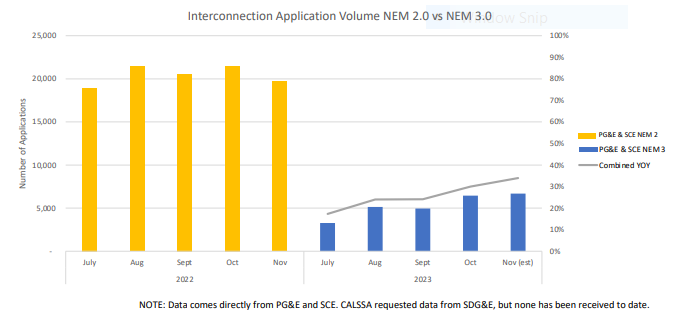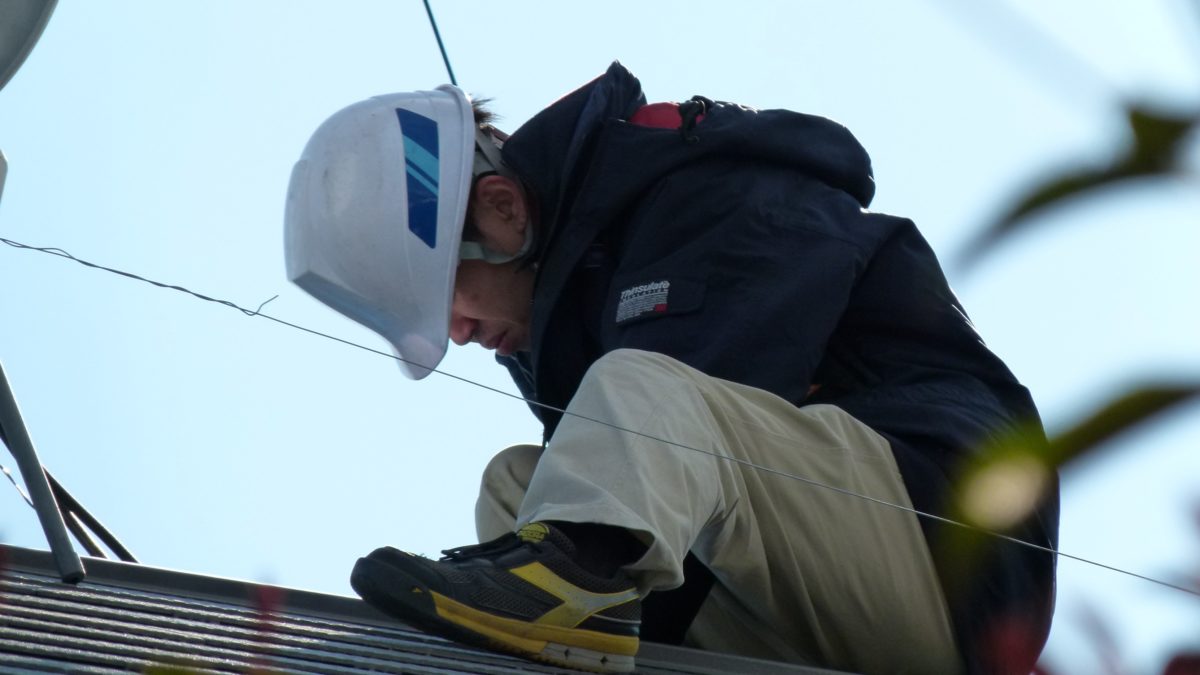California, once a leader in residential solar, is feeling the effects from unpopular policy changes like the introduction of Net Energy Metering (NEM) 3.0 and more recent market rate cuts for rooftop solar generation by renters, schools, and farms.
The two policy changes cut compensation rates for exporting local, clean solar generation to the grid by about 75%. State regulators said the change facilitating was a necessary evolution in the grid, but opponents argued that the move was a thinly veiled move to protect the profits of major utilities.
“We are launching the solar and storage industry into the future so that it can support the modern grid. The new tariff promotes solar systems and battery storage with a focus on equity,” said the California Public Utilities Commission (CPUC) upon passing NEM 3.0.
“The CPUC’s final proposal is a loser for California on many levels. For the solar industry, it will result in business closures and the loss of green jobs. For middle class and working-class neighborhoods where solar is growing fastest, it puts clean energy further out of reach,” said the California Solar and Storage Association (CALSSA).
Which prediction came true?
Unsurprisingly, gutting the return on investment for solar for homeowners, renters and small businesses in California did not encourage installations.
Utility interconnection request data shows that solar sales have fallen between 66% and 83% year-over-year following NEM 3.0.
What’s more, there have been massive layoffs industry wide. CALSSA said over 17,000 solar jobs have been lost in 2023, representing 22% of all solar jobs in the industry.

Based on interviews of residential solar installers across the state, CALSSA found that 59% of installers expect more layoffs ahead, and 63% expect to have cash flow issues over the next three quarters. About 70% expressed concern about their business outlook, while 43%, or about 300 businesses, said it will be difficult to remain in business.
To meet its clean energy goals, California needs to install 3.5 times as much solar and seven times as much energy storage as what is cumulatively installed today. With minimal demand, layoffs and business closures, it will be very difficult to meet these requirements.
CALSSA said that short of reversing the decision altogether, there are a few things CPUC can do to repair the damage done. First, it recommends rejecting the Income Graduated Fixed Charge proposed by utilities that would assess minimum bills on all customers, regardless of whether they pull electricity from the grid or not.
Other recommendations include:
- Simplify AB 2143 (Carrillo) to protect small businesses installing solar and storage
- Do not limit licensed solar contractors from installing solar + batteries
- Launch The Million Solar Batteries Initiative: Create new, massive investments in energy storage for all consumers (low-, working-, middle-class and non-residential consumers).
- Cut red tape
- Eliminate interconnection delays and establish penalties for utility non-compliance
- Simplify permitting at city and county level by fully implementing SB 379 (Wiener)
“CPUC commissioners claimed their decision was about ‘launching the solar and storage industry into the future.’ Instead they caused the nation’s largest-ever loss of clean energy jobs, pushed once thriving businesses out of the state or into bankruptcy, and derailed California’s fastest and most accessible path to a clean energy future,” said Bernadette del Chiaro, executive director of CALSSA.
Watch the October 2023 pv magazine USA Roundtables discussion of the California rooftop solar and storage market, including commentary from del Chiaro and other market experts below:
This content is protected by copyright and may not be reused. If you want to cooperate with us and would like to reuse some of our content, please contact: editors@pv-magazine.com.









This is horrible and needs to be canceled immediately. Where are you Governor Newsom?
This Governor is all for himself. Any decisions he makes is Shystie & has a benefit to himself or big companies that are greedy. What starts out as a honest & good thing turns to shit, once this man Governor Newsome get involved. All he see’s is profit that doesn’t help anyone but himself or interest that benefit himself. Doesn’t care about the people or who it effects He has no soul! Wish this man would disappear along with his hair gel. Ugly man!
The EV market is doing fine. It is false news that EV sales have fallen. American manufacturers have to reduce their fast charging time to 20%to80% in less than 20 minutes. Kia doubled their EV6 sales because Americans want fast charging times and not the junk USA EV makers put out. Shameful!
This isn’t about EVs. It’s about residential solar systems.
Large utilities do not have the absolute right to remain in business insuring control via monopolies.
This monopoly is being used to squeeze out any competition insuring their own income and profitability at the expense of the people in their service area.
A monopoly is socialistic or even possibly communistic in nature verses a free market style where the best supplier of goods and services rises to the top.
A good option for the production of energy is an energy cooperative where the customers of the service area are considered as owners and have a vote on the way that the utility proceeds and does business.
I think that KIUC (Kauai Island Utility Co-op) is doing a good job and is responsive to the people of Kauai.
It may be a good model for the people of California (and the rest of the Nation) to look at and possibly implement in which ever way suits the people in that service area best. I think this type of system is much more likely to embrace new technology, flexibility and the interests of the people in their service area rather than the old monopoly systems that are primarily concerned with maintaining control in order to line their own pockets.
Ònce again, when solar is forced to pay its own way, it can’t do it. Solr does not run on the sun, it runs on happy thoughts, pixie dust, and subsidies.
You’re missing the point. It’s not feasible that if a person produces 20kwh of solar, utilities will act as if they’ve only produced 15 and then charge them for the other 5.. Solar can pay for itself perfectly fine, but it can’t subsidize those not on it.
I’m not sure that Solar runs on pixie dust, but I am sure that most of the panels are produced by child and (effectively) slave labor.
The math in Jaxon’s reply post employs pixie dust: Solar is self-supporting when completely off-grid, otherwise users depend on the grid (other utility customers) to subsidize their production shortfall.
I’ve worked in the solar industry for 10 years, making a decent living to help support my family. I’m on my way out now, though, because after the NEM 3.0 change last year, my income has dropped by 30%. The CPUC is directly responsible for killing my job.
If “major” utilities aren’t making a profit there will be no utilities. People understand this right??
The for profit model has made America’s medical system the worst in the Western world and the for profit electric utility will do the same for our power needs. Failure to care for our society in order to make money will be the downfall of the USA…….
If I’m not using the major utility, why should I be paying them?
Utilities need to pay residential solar producers at least as much or more than they “pay” for supplemental power purchased from other regions…the other power source they have with no underlying investment. That said there can legitimately be a charge for the connection to the grid….leveraging the utilities as a virtual battery. Finally there should be no charge for those not connected to the grid at all.
This is what happens to “created markets”. Someone can “uncreate” them. Grid connected solar has never really been economically viable without “governmental/political” force of some kind and other than subsidizing homeowners and solar contractors, there’s really no benefit to society at large. (Or the Planet, if that’s your fantasy motivator). Off grid solar, by contrast, has always performed a valuable, market driven function and is therefore, solvent. My first solar energy system sale was in 1978, a pool heating system and my latest was an off grid battery system, last week.
NEM 3 is a disaster. Hold Gov. Newsom and CPUC responsible for this blatant scam to. promote corrupt PG&E over the people of California and the environment. Call the governor and the CPUC and tell them how terrible their actions are for us, the people and voters of California.
I was trying to scramble and get in prior to 2.0 and wasn’t able to make it happen – everyone was trying to do the same. Nobody I know including myself tried to scramble before 3.0 – we basically abandoned our solar aspirations at that point, there is no benefit or margins left in it at that point.
CPUC and PGE are basically two scam organizations.
PG&E life cycle:
Cause fires by your negligence, get sued by people affected, turn to CPUC to increase rates, and then pass those costs to the customers.
Wash, rinse, repeat
Can one not install solar and batteries yet never take the NEM 3.0 dunnage because oops, all microgrids? Then profit (or net 0 with a normal, small sort of tie-in fee and disused equipment to clear of wildlife.)
Personally I feel the CPUC should all be fired, as they clearly are oblivious about what is right for California and the people residing in California. My personal opinion is they are being payed off by the big utilities to make policies that benefit the big utilities.
Solar has turned into a racket in California, and that ‘model’ is being copied elsewhere. The utilities are quasi- government entities receiving corporate welfare they call NEM 3.0. Privatize the profits and socialize the losses. Solar is cost prohibitive to begin with and now this makes solar a non-starter. It’s done thanks to these criminal cartels masquerading as so called ‘regulators’. Worthless crooks destroy everything that is positive. They’re not going to like the end result they’ve manufactured.
For those who live in windy areas – beach and desert cities – small boat sized windmills can be added (unless red tape says they can’t) to the roof which generate during stormy periods. They are 3 times the cost of panels. But combined with larger batteries and disconnecting the fridge and using ice during cloudy weeks if there are no windmills, cutting the utility cord and being 100% off grid is feasible in sunny CA. Perhaps after getting more panels as well. Fight back by not being a customer.